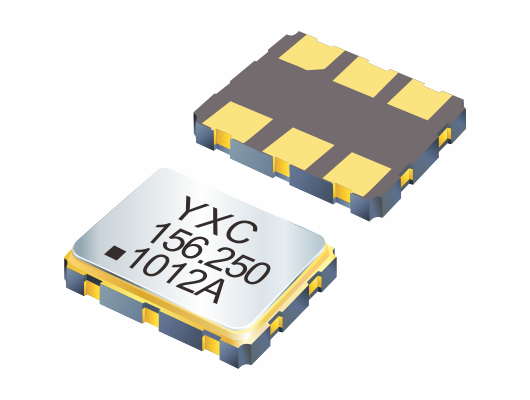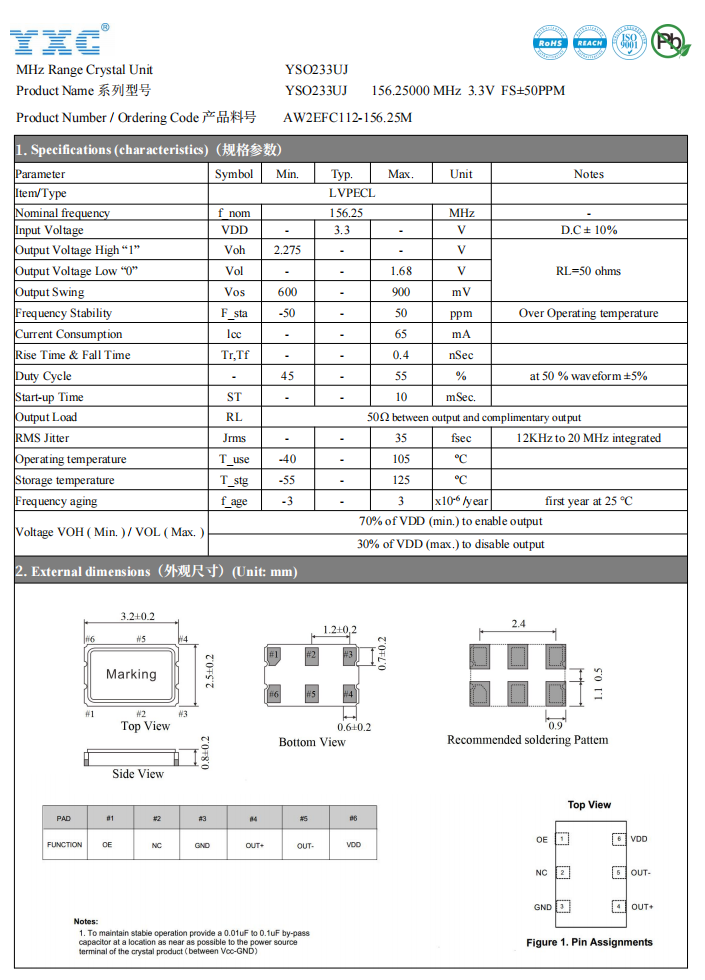In the field of high-speed data communication and optical modules, the choice of clock source directly determines the system's transmission rate and link stability. Yangxing Technology's YSO233UJ series differential crystal oscillators are specifically optimized for the critical frequencies of 156.25MHz and 312.5MHz in optical modules, providing precise clock support for 800G, 1.6T, and 3.2T optical modules with ultra-low jitter, wide-temperature stability, and high reliability.
一、Advantages of Key Frequency Points
· 156.25MHz
Widely used in Ethernet 10G/100G/400G/800G/1.6T/3.2T interfaces, it is the core reference clock for high-speed optical modules.
At this frequency, using LVPECL output mode, the YSO233UJ exhibits a jitter as low as 35fs, significantly reducing the bit error rate (BER) and ensuring data integrity in high-speed links.
High-frequency photolithography wafer design avoids phase noise accumulation caused by frequency doubling, ensuring high signal quality even in high-bandwidth, high-speed SerDes channels.
· 312.5MHz
Primarily used for higher-speed SerDes interfaces and next-generation ultra-high bandwidth optical module designs, it is a crucial frequency for the clock architecture of 800G/1.6T/3.2T optical modules.
At this frequency, the YSO233UJ still provides extremely low jitter, meeting the clock input requirements of 400GbE/800GbE/1.6TbE Ethernet PHY chips and DSP chips.
Its low phase noise characteristics at high frequencies make it an ideal clock source for low-latency interconnects and high-speed switch backplanes.
二、Core Features of the YSO233UJ Series Differential Crystal Oscillator
1. Ultra-Low Jitter
At 156.25MHz with LVPECL output, the jitter value is as low as 35fs; excellent jitter performance is maintained even at a high frequency of 312.5MHz. Adaptable to high-speed SerDes and optical module DSPs, ensuring minimal BER (Bit Error Rate) in high-speed interconnects.
2. Wide Temperature Range and High Stability
Operating temperature range covers -40°C to 105°C, with optional extension to -40°C to 125°C, meeting the extreme environmental requirements of data centers and telecom base stations. Total frequency difference +50ppm ensures frequency consistency and protocol compliance of optical modules during long-term operation.
3. Multiple Output Compatibility
Supports LVDS, LVPECL, and HCSL output modes, flexibly matching different optical modules and main control chip architectures.
Simplifies peripheral design, reduces system BOM costs, and accelerates product development.
4. High-Frequency Photolithography Wafer Process
Directly outputs the target frequency (156.25MHz/312.5MHz), avoiding the additional jitter caused by frequency multiplication or division schemes.
Higher signal quality and lower phase noise, particularly suitable for high-speed optical modules and core switching applications.

三、Application Value in Next-Generation Optical Modules
1、800G Optical Module: Ensures the stability of high-speed optical link transmission when using 156.25MHz as the core clock input; supports the precision clock requirements of high-speed DSP chips at 312.5MHz.
2、6T Optical Module: Ultra-low jitter performance is directly related to the system BER level. The YSO233UJ meets next-generation interconnect standards through optimized phase noise performance.
3、3.2T Optical Module: In high-bandwidth applications, the 312.5MHz clock frequency is particularly critical. The YSO233UJ's high reliability and ultra-high-speed SerDes link provide a solid guarantee.
In conclusion, the YSO233UJ series, a high-performance differential crystal oscillator launched by Yangxing Technology for the high-speed optical communication market, focuses on two key frequency points: 156.26MHz and 312.5MHz. With ultra-low jitter of 35fs, stability of ±50ppm, and wide temperature range support, it provides precise clock support for 800G, 1.6T, and 3.2T optical modules. It not only optimizes link performance but also lays a solid foundation for next-generation data centers and ultra-high-speed interconnects.